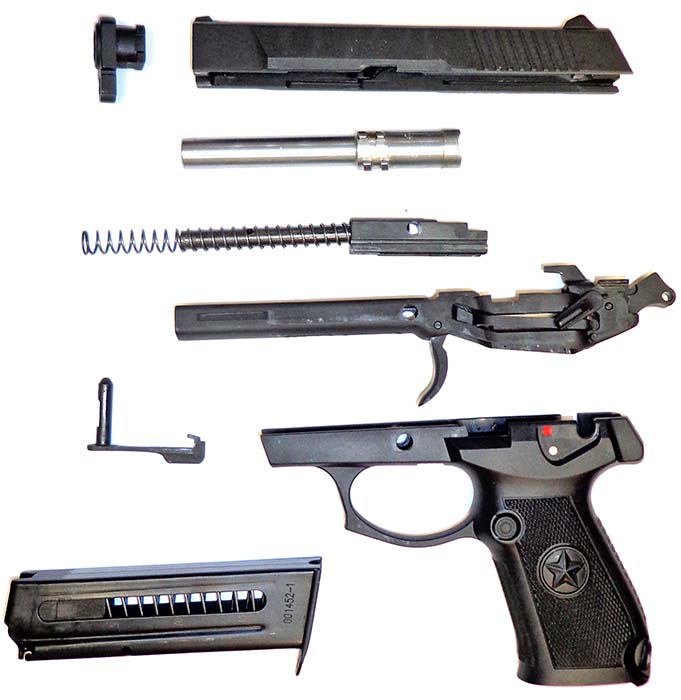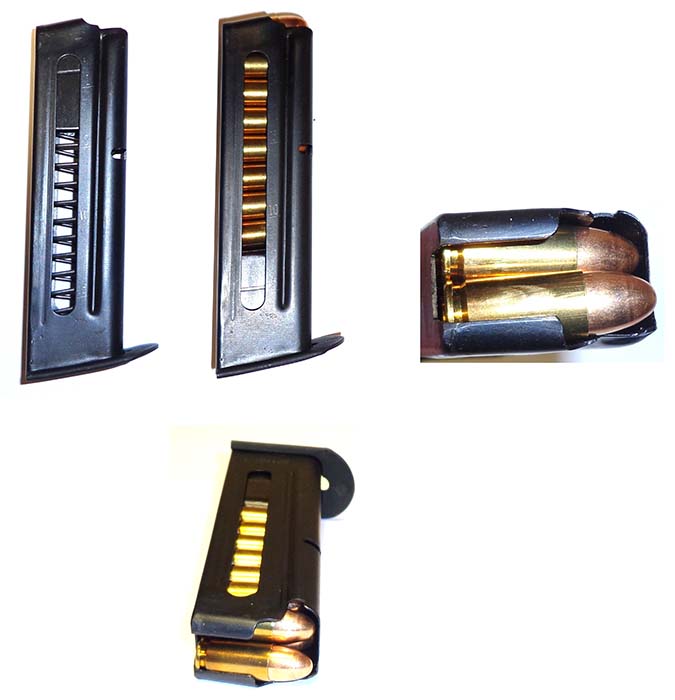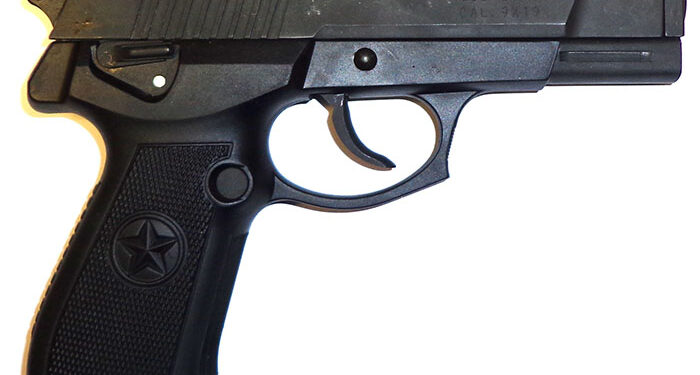By Christopher R. Bartocci
Throughout NATO countries, the service pistol has been upgraded from its post WW II variations. Many countries who had issued the post war Browning High Power have since gone to modern combat pistols such as the Beretta 92FS, SIG P226, Glock 17 and H&K USP, to name just a few. However, the former Soviet Union and other Warsaw Pact countries have not been so proactive at getting a more modern service pistol. The steadfast for these countries including China, East Germany, Bulgaria and Romania, for instance, used the standard 9x18mm Makarov pistol. Hardly what you would call a combat pistol, this falls more in line with a personal defense weapon. The 1951 developed Soviet Makarov pistol is a double/single action pistol with a safety/decocking lever. It has a capacity of 8 rounds of 9x18mm caliber ammunition. The Makarov ammunition is not as powerful as the 9x19mm thus is fired from a blowback operation.
The Chinese felt it was time to improve their issue pistol; not only for military but for law enforcement use as well. The Chinese have been known to copy other weapon designs and produce them; some notable examples would be the M1911A1, AR-15, M14, SIG P226 and so on. When it comes to making Chinese law enforcement and military weapons, the Chinese often will look at different weapon systems, pick their most desirable features and build one very reliable and simple gun.
The new pistol created is known as the CF98: the 98 stands for the year the pistol was developed. This is by all intent and purposes a modern combat pistol. Chambered in the full power 9x19mm caliber, this pistol has a double/single trigger. In other words, after the pistol is loaded, the safety/decocking lever is pushed down decocking the hammer. When the safety is put back on fire, the trigger is pulled in the heavy double action mode. As the trigger is drawn to the rear, the hammer is as well. This creates a heavy double action trigger pull. Once the pistol fired, the slide comes back and recocks the hammer and now the pistol is fired on the single action mode. This consists of a short and lighter trigger pull.

The operating mechanism is quite interesting on this pistol as well. This is not the traditional Browning-type tilting barrel locking system. The roots of this pistol go back to Gene Stoner and Reed Knight with the development of a rotating barrel locking mechanism. This design was sold to Colt and introduced as the All American 2000 pistol. The rotating barrel is similar to that of a rifle rotating bolt mechanism. The barrel does not drop down at an angle to unlock; this barrel pushes straight rearward until the locking surfaces clear and the slide comes straight back. This offers very unique and controllable recoil as the recoil is far more of a push rearward rather than a violent muzzle flip. Colt’s lawyers got involved and the trigger pull on the All American 2000 was so heavy that it was difficult to hit the target. The pistol never gained popularity and was very quickly discontinued. Colt made one last attempt to make the rotating barrel concept work with their entry into the SOCOM trials for the MK23 pistol. This was lost to Heckler & Koch. Colt discontinued using the operating system. The next company to look at this operating system was Beretta. They took the design, reworked it and released their Cougar series pistols in 1994. These pistols would be chambered in 9x19mm, .40, .357 SIG and .45 Auto. These pistols worked very well and saw adoption by numerous law enforcement agencies. Beretta was successful in making this operating system work. Then in 2004, Beretta introduced their next generation pistol, the Px4. This was not a shot at an updated cougar but a new design using advanced polymer lower receiver, improved locking block and barrel and finish. This pistol has been adopted throughout the world in its various calibers.
The Chinese saw this rotating barrel design and liked it. They would make some slight modifications for their pistol. The unlocking stroke is shorter on the Chinese design. The stroke goes about half way as compared to the Beretta and then unlocks. The 4.33 inch barrel is chrome plated with 6 lands and grooves and right hand twist. The external finish of the barrel is stainless steel color. To increase accuracy, the CF98 has a M1911 type barrel bushing. The recoil spring on the CF98 has similarities to the Glock compact spring and Gen 4 recoil spring assemblies. There is a standard spring guide with a spring loaded plunger in the end of the spring guide. Then the recoil spring slides over that assembly. The plunger takes additional recoil and stress off of the impact of the frame and slide.

The trigger mechanism is modular and comes right out of the frame in one piece. This includes the trigger, safety/decocker and hammer assembly. When the pistol is loaded, the safety is pushed upward and the hammer decocks. Now the safety is engaged and the rearward movement of the trigger is blocked. When the safety is pushed downward the pistol is ready to fire in the double action mode. Of course the hammer can be manually pulled back to obtain single action trigger pull. This unit fits into the frame, which is manufactured of a very durable polymer. The magazine release is reversible to accommodate a left or right handed shooter. The trigger pull of the sample CF98 was average for a combat pistol. The single action pull broke at 5 3/4 pounds and the double action was a little on the heavy side at 13 3/4 pounds. There is a lanyard ring on the bottom left rear of the pistol’s grip.
The slide is very well made with a parkerized finish. There is a passive firing pin block to prevent firing unless the trigger is pulled all the way to the rear. On the extractor is a loaded chamber indicator that may be felt with your trigger finger or visually seen. The pistol has a three dot sight system.
The magazine is also unique. Most all modern double column magazines feed from single column feed lips. The CF98 is double column just like one would find on an H&K MP5 or an Uzi. They sit side by side and one feeds from the right and the other from the left side. The pistol does not have a large feed ramp but feeds flawlessly with ball ammunition. The magazine holds 15 rounds of 9x19mm ammunition, which is sufficient to provide cover fire if need be. The big negative observed on the magazine was how open and exposed the ammunition is by cutouts in the walls of the right and left side of the magazine. This would be catastrophic in a desert environment. Sand would work its way into the shot column and prevent the rounds from rotating up the shot column and cause failures to feed. The pistol was fired under controlled range conditions and there were no failures to feed at all.
The pistol was test fired with PMC 115 grain 9mm ball ammunition. There were a total of 50 rounds fired. There were no malfunctions during the firing. The same magazine was used for all testing. Recoil was very pleasant. Due to the inline construction offered by the rotating barrel mechanism, the recoil was soft and more of a push than a snap found with the more standard modified browning locking system where the barrel moves rearward and down to unlock. The CF98 is very well made, accurate and comfortable to shoot pistol and, like most Chinese service weapons, very robust and reliable. Currently in service with the Chinese and Hong Kong armies as well as the Beijing police to name some of the biggest users, the CF98 continues to get adopted by additional police and military customers. The pistol is also currently being produced in Pakistan.
| This article first appeared in Small Arms Review V18N4 (August 2014) |











